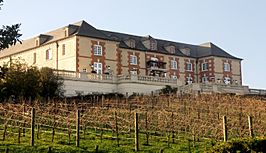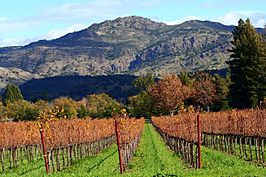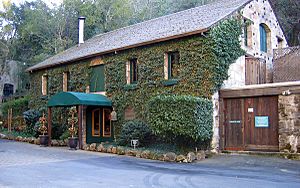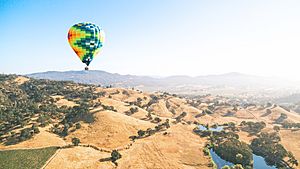Wine Country facts for kids
| Wine region | |
|
Top to bottom to right: Domaine Carneros in Los Carneros AVA; Castello di Amorosa in Napa Valley AVA; the historic Walters Ranch Hop Kiln; Via Sattui Winery; Chateau Montelena in Calistoga AVA; Inglenook in Rutherford AVA; Napa Valley in autumn.
|
|
| Year established | 1812 |
|---|---|
| Years of wine industry | 1812–present |
| Country | United States |
| Part of | California wine |
| Sub-regions | Wine Country AVAs |
| Climate region | Mediterranean |
Wine Country is a special area in California, located north of the Bay Area. It is famous around the world for growing grapes and making wine. This region is also known for its many places that make wine (called wineries), delicious food, fancy restaurants, and interesting old buildings.
People have been growing grapes and making wine here since 1812. That's when Spanish missionaries from Mission San Francisco Solano first planted vineyards. Today, there are over 800 wineries in the North San Francisco Bay Area. Most of them are in valleys like Napa Valley and Sonoma Valley. Grapes also grow on higher lands, such as Atlas Peak.
Many towns are part of Wine Country, including Santa Rosa, Healdsburg, and Sonoma in Sonoma County. In Napa County, you'll find towns like Napa and St. Helena.
Contents
What are Wine Appellations?
Wine Country includes the counties of Napa, Sonoma, Mendocino, Lake, and Solano. These areas have special zones called American Viticultural Areas (AVAs). An AVA is a specific grape-growing region that has unique features like climate and soil.
Here are some of the AVAs in each county:
- In Sonoma County: Alexander Valley, Bennett Valley, Dry Creek Valley, Russian River Valley, and Sonoma Valley.
- In Napa County: Atlas Peak, Los Carneros, Napa Valley, Oakville, and Rutherford.
- In Mendocino County: Anderson Valley and Mendocino.
- In Lake County: Clear Lake and High Valley.
- In Solano County: Suisun Valley and Green Valley.
The larger North Coast AVA covers most of these counties. Also, the names of the counties themselves can be used as official wine regions.
History of Wine Country
The Wine Country has a long history, even before Europeans arrived. Around 8000 BC, several Native American tribes lived here, including the Pomo and Coast Miwok. These early people farmed, but they didn't grow grapes for wine.
Later, during the time of Mexican rule and after, European settlers came to the Wine Country. They brought new ways of farming, including growing grapes and making wine. The town of Sonoma is very important in California's history. It's known as the place where American California began. A person named Agoston Haraszthy is often called one of the fathers of the California wine industry. He planted many grapes in Sonoma County.
In 2017, some parts of California's Wine Country were badly affected by large wildfires.
Animals and Plants of Wine Country
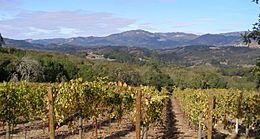
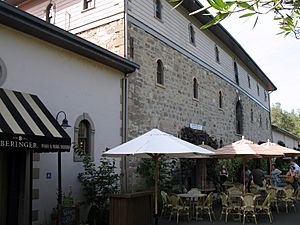
Wine Country is home to many different kinds of animals and plants. In the rivers and streams, you can find fish like Chinook salmon and steelhead. Scientists have studied how these fish move in places like Sonoma Creek and the Napa River. They found that the places where fish lay eggs have become less healthy over time. This is mainly because of dirt washing into the water and trees being removed from riverbanks.
You can also find different kinds of salamanders, snakes, and frogs. The California red-legged frog, which is a threatened species, lives in some northern areas. There are also several endangered species in the marshy areas, like the Ridgway's rail bird and the salt marsh harvest mouse.
In the higher areas, you'll see forests with different types of oak trees, chaparral bushes, and open savannah woodlands. Here, you might spot black-tailed deer, coyotes, wild turkeys, and large birds like red-tailed hawks. Sometimes, you might even see a mountain lion. Common trees include Coast live oak and Douglas fir.
Tourism in Wine Country
Tourism in Wine Country has grown a lot. In 1975, there were only 25 wineries in Napa Valley. Today, there are over 800 wineries in Napa and Sonoma Counties! People visit not just for wine tasting, but also for fun activities like hiking, bicycling, and hot air balloon rides. They also come to see historic places and enjoy the many food choices.
Many famous chefs have restaurants in Wine Country. Besides the wineries, visitors enjoy the beautiful coastline along the Pacific Ocean, the Russian River valley, tall redwood trees, and natural areas like hot spring baths and petrified forests.
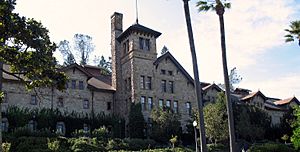
The increase in tourism has also brought some challenges. For example, traffic can get very busy on roads like California State Route 29, especially on summer weekends. The Napa Valley is also seeing more buildings and roads being updated. There have been discussions about rules for people who rent out rooms in their homes, like requiring them to register with the city.
Images for kids
-
Buena Vista Winery, in Sonoma, is the oldest commercial winery in California, founded in 1857.
-
Vineyard on Sonoma Mountain AVA with background of the Mayacamas Mountains.
-
The Charles Krug Winery, founded in 1861, is on the National Register of Historic Places.
-
Beringer Vineyards is Napa Valley's oldest continuously operating winery.
-
The Culinary Institute of America at Greystone is a prestigious Napa culinary school.
See also
 In Spanish: Wine Country (California) para niños
In Spanish: Wine Country (California) para niños


